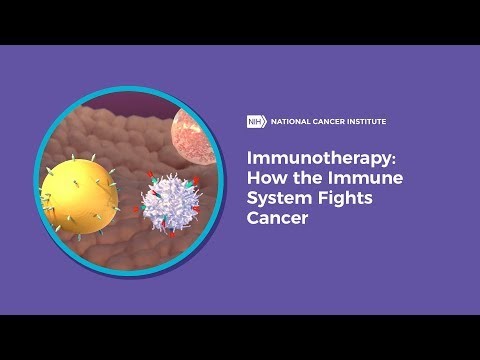Immunotherapy
Immunotherapy can be either active or passive. Active immunotherapy involves setting an immune response in the cancer patient to fight cancer cells. In passive immunotherapy, immune molecules are given to patients who do not produce them on their own. Both approaches can be specific or nonspecific.
Use link or picture below to learn about nonspecific immune stimulation, T-cell transfer therapy, and immune checkpoint inhibitors, which are 3 types of immunotherapy used to treat cancer.
Specific Active Immunotherapy
One way the immune system can recognize differences among cells is by molecules called antigens that appears on the cell surface. In active immunotherapy, cancer cells are analyzed in the lab and their antigens are identified. Then, a treatment is designed to stimulate a specific immune response against them. This is called specific active immunotherapy.
Nonspecific Active Immunotherapy
The nonspecific active approach uses agents that set in motion a general immune response, activating a wide range of immune cells. The approach aims at strengthening the overall activity of the immune system instead of selectively arousing those elements most able to fight cancer.
The agents used in this method include interferons and interleukins (IL-2 and IL-12, for example), as well as bacillus (or bacilli) Calmette-Guerin (BCG), the organism that causes tuberculosis. The immune response to tuberculosis can cause certain cancers to regress. Researchers have achieved success by injecting nonspecific agents directly into body cavities where tumors are located. In two studies, for example, the use of BCG led to the complete remission of recurrent bladder tumors in about 70 percent of the patients.
T cell Transfer Therapy - t-cells are removed from the patient, then modified in the laboratory to enhance their ability to target the patient's cancer. Then cells once grown are returned to the patient via an intravenous route.
Immune Checkpoint Inhibitors - These drugs block the cancers ability to avoid attack by the body immune system.
Passive Immunotherapy
Passive immunotherapy, sometimes called adoptive immunotherapy, gives the cancer patient antibodies and other agents so that the patient adopts an immune response that has been developed in a test tube.
The passive approach can be specific or nonspecific. Specific treatments include monoclonal antibodies (MABs), the so-called magic bullets, which can be designed to target certain cancer cells.
One nonspecific technique involves removing some of the person's T-cells, culturing the cells in the lab, and then injecting expanded populations of the treated cells into cancer patients.
An alternative approach is to activate lymphocytes taken from a person's tumor to create yet another agent, called tumor-infiltrating lymphocytes (TILs) and returning these "stranger" cells to the patient where they can fight the cancer cells.
Updated: December 21, 2023
Suggested Citation
SEER Training Modules: Immunotherapy. U.S. National Institutes of Health, National Cancer Institute. Cited 04 January 2026. Available from: https://training.seer.cancer.gov.





